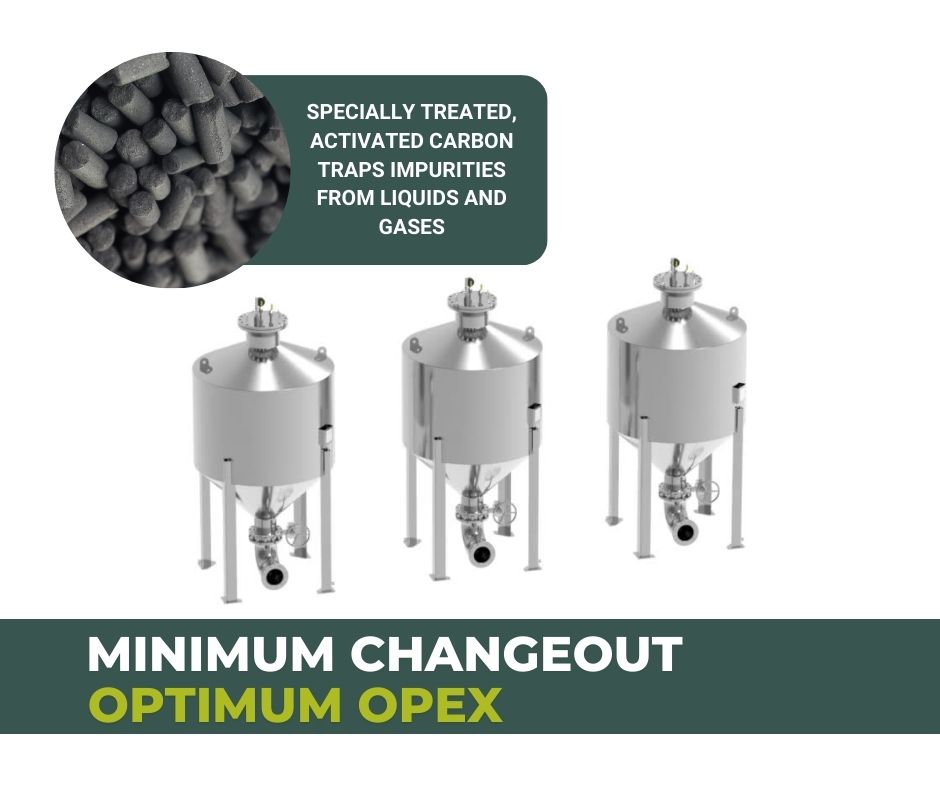Anaerobic digestion is a biological process that breaks down organic matter, such as food waste, agricultural residues, and sewage sludge, in the absence of oxygen. This process is carried out by a diverse group of microorganisms, primarily bacteria, in an oxygen-free environment.
During anaerobic digestion, organic materials are decomposed into biogas and nutrient-rich digestate. The biogas produced is a mixture of methane (CH4) and carbon dioxide (CO2), and it can be used as a renewable energy source for electricity generation, heating, or even as a vehicle fuel. The digestate, which is the solid and liquid residue left after digestion, can be used as a fertiliser due to its nutrient content.
Anaerobic digestion has several environmental and economic benefits, including the reduction of organic waste in landfills, the generation of renewable energy, and the production of valuable byproducts. It is commonly used in wastewater treatment plants, agricultural operations, and industrial facilities to manage organic waste and harness the potential energy stored in it.
Anaerobic digestion not only provides a sustainable way to manage organic waste but also generates renewable energy in the form of biogas, which can be used for heat, electricity, and even vehicle fuel.
Eneraque Renewables: Anaerobic Digestion Technology.
Anaerobic Digester: The heart of the anaerobic digestion process, this tank or vessel provides an oxygen-free environment where microorganisms can break down organic materials. There are various types of digesters, including continuous stirred-tank reactors (CSTR), plug flow reactors, and more.
Feedstock Handling System: This equipment prepares and introduces the organic feedstock (such as food waste, agricultural residues, or sewage sludge) into the digester. It can include shredders, grinders, and pumps to ensure the feedstock is properly processed and mixed.
Mixing System: Efficient mixing is crucial to maintain uniform conditions within the digester, promoting microbial activity and preventing stratification. Mechanical mixers or gas recirculation systems are often used for this purpose.
Heating System: Anaerobic digestion is temperature-sensitive, and maintaining the appropriate temperature range is essential for optimal microbial activity. Heating systems, such as heat exchangers, boilers, or even solar panels, help control the temperature within the digester.
Here are some common feedstocks suitable for anaerobic digestion:
- Agricultural Residues: Crop residues, such as maize, grass, wheat, rye, triticale, palm oil mill effluent, are rich in organic matter and can be used in anaerobic digesters.
- Animal Manure: Livestock manure, such as cow, pig, and poultry manure, is a popular feedstock due to its high organic content and nutrient value.
- Food Waste: Food scraps, kitchen waste, and expired food products can be used as feedstock in anaerobic digesters. Food waste from households, restaurants, and food processing industries is commonly utilised.
- Municipal Sewage Sludge: Sewage sludge from wastewater treatment plants is another common feedstock. It contains a mix of organic materials from human waste and other sources.
- Organic Industrial Waste: Organic waste generated by various industries, such as breweries, distilleries, and food processing facilities, can be suitable feedstocks for anaerobic digestion.
- Fats, Oils, and Grease (FOG): Grease trap waste and used cooking oils can be processed in anaerobic digesters to produce biogas.
- Aquatic Plants: Some aquatic plants, like water hyacinths and algae, can be used as feedstock for anaerobic digestion.
- Organic Municipal Solid Waste (MSW): Some municipalities include organic fraction in their waste streams, which can be collected and used as feedstock for anaerobic digestion.
- Agro-Industrial Residues: By-products from agro-industries, such as fruit and vegetable processing residues or sugarcane bagasse, can be used in anaerobic digestion.
- Animal Manure: Livestock manure, such as cow, pig, and poultry manure, is a popular feedstock due to its high organic content and nutrient value.
- Food Waste: Food scraps, kitchen waste, and expired food products can be used as feedstock in anaerobic digesters. Food waste from households, restaurants, and food processing industries is commonly utilized.
- Municipal Sewage Sludge: Sewage sludge from wastewater treatment plants is another common feedstock. It contains a mix of organic materials from human waste and other sources.
- Energy Crops: Fast-growing energy crops like maize (corn), sorghum, and switchgrass are cultivated specifically for use in anaerobic digestion systems due to their high biomass yield.
- Organic Industrial Waste: Organic waste generated by various industries, such as breweries, distilleries, and food processing facilities, can be suitable feedstocks for anaerobic digestion.
- Fats, Oils, and Grease (FOG): Grease trap waste and used cooking oils can be processed in anaerobic digesters to produce biogas.
- Aquatic Plants: Some aquatic plants, like water hyacinths and algae, can be used as feedstock for anaerobic digestion.
- Organic Municipal Solid Waste (MSW): Some municipalities include organic fraction in their waste streams, which can be collected and used as feedstock for anaerobic digestion.
- Agro-Industrial Residues: By-products from agro-industries, such as fruit and vegetable processing residues or sugarcane bagasse, can be used in anaerobic digestion.
When selecting a feedstock for anaerobic digestion, it’s essential to consider its composition, moisture content, and potential contaminants. The ideal feedstock will vary depending on the specific objectives of the anaerobic digestion project, the available resources, and the local regulations. Additionally, proper feedstock preparation and management are crucial to optimise biogas production and maintain the stability of the anaerobic digestion process.







